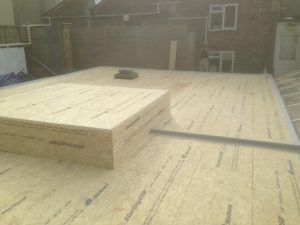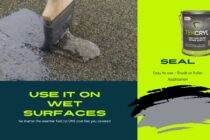Explore the Best Boards for Flat Roofs
Discover the top choices for durable and reliable flat roofing solutions, ensuring your roof stands the test of time.
Durability and Strength
Cost-Effectiveness
Ease of Installation
How To lay OSB Boards

Key Information to prevent GRP Failure


credit: composite roof supplies ltd
Best boards for GRP flat roofs
OSB3 Tongue & Groove ( Oriented Strand Board ) is the roof deck of choice for laying a new fibreglass roof. Its rough textured surface allows the resin to get a firm grip and key into the board, meaning there is very little chance of delamination ( the matting peeling away from the surface of the wood ). Standard square edge boards allow 3mm gaps between adjoining boards for expansion.
So Which are Best boards for GRP flat roofs ?
When it comes to flat roofs, choosing the right roofing boards is crucial for ensuring the longevity and durability of your roof. With so many options available, it can be overwhelming to decide which one is best for your needs. In this guide, we’ll explore the top roofing board options for flat roofs and help you make an informed decision.
Understand the importance of roofing boards for flat roofs.
Roofing boards are a critical component of any flat roof system. They provide a stable and level surface for the roofing membrane to be installed on, as well as insulation and protection from moisture. Without proper roofing boards, your flat roof could be at risk of leaks, damage, and premature failure. It’s important to choose the right type of roofing board for your specific needs to ensure the longevity and durability of your flat roof.
Best boards for GRP flat roofs in minor detail
- OSB (Oriented Strand Board) – this type of board is made up of layers of wood strands that have been compressed and bonded together with resin. It is strong and stable, making it a popular choice for flat roofs.
- Plywood – this type of board is made up of layers of thin sheets of wood that have been glued together. It is also strong and stable, but it is more expensive than OSB.
- MDF (Medium-Density Fiberboard) – this type of board is made up of compressed wood fibres. It is more stable than plywood, but not as strong.
- Chipboard – this type of board is made up of compressed wood chips. It is less expensive than OSB, but it is not as strong.
All the above-mentioned boards are suitable for a GRP flat roof, the best board will depend on the specific application and the requirements of the building. It is always best to consult a professional for the best advice for your flat roofing needs.
Best boards for GRP flat roofs – Our choice is: OSB3 Tongue & Groove (Oriented Strand Board)
T&G – The best is tongue and groove OSB3 but this can be tricky to get hold of. Some fibreglass suppliers and timber yards will deliver T&G ( tongue & groove ) but this can make costs spiral upwards which can be a problem in a competitive market. For any medium to large roof though make the effort to acquire OSB T&G as it has expansion gaps built in by design, which is nice and will make for a better job.
- T&G profile prevents the boards from distorting (or“dishing”) as the laminate cures.
- T&G boards do not require an additional CSM ‘bandage’ on the joints.
- T&G boarding saves time and materials.
- T&G boards do not have to be joined on beams or noggins.
- Used writing side up the fibreglass bond is much stronger than on plywood.
- No surface preparation is required (plywood must be sanded before applying laminate)
- 8×2 boards are easier to handle and transport.
- Writing side up! Note the small gap formed along the joints – resin will run into the gap and bond the boards together when the laminate is applied.
When using a square edge be prepared to:
- Leave a 3-4mm gap between each board edge (for internal movement and expansion)
- Vigorously abrade plywood to improve the bond with 40-60 grit red aluminium oxide paper
- Apply masking tape to all joints to prevent resin ingress when the bandage is applied *ensure resin can soak into the tape do not use duck tape this is an old-style method,
- Apply an additional glass bandage (450g x 75mm) prior to the main laminate.
Take a look at the science behind the OSB BOARD
Q&A for Best Boards for GRP Flat Roofs:
Q1: Why is OSB3 Tongue & Groove recommended for laying a fibreglass roof? A1: OSB3 Tongue & Groove is the preferred roof deck for fibreglass roofs due to its rough textured surface. This texture allows the resin to firmly grip and key into the board, minimizing the risk of delamination, where the matting peels away from the wood surface.
Q2: How does the rough texture of OSB3 enhance the fibreglass roof application? A2: The rough surface of OSB3 provides an excellent substrate for the resin to adhere to, creating a strong bond between the fibreglass material and the roof deck. This enhances the overall durability and integrity of the fibreglass roof.
Q3: What is the significance of the Tongue & Groove feature in OSB3 for fibreglass roofing? A3: The Tongue & Groove design in OSB3 ensures a tight and secure fit between adjoining boards. This feature helps prevent water penetration and provides a smooth, even surface for the fibreglass application.
Q4: Are there specific guidelines for installing OSB3 for fibreglass roofs? A4: Standard square edge boards are recommended, allowing 3mm gaps between adjoining boards for expansion. Following these guidelines ensures proper ventilation and accommodates any potential movement of the boards, promoting the longevity of the fibreglass roof.
Q5: Can other types of boards be used for fibreglass roofs? A5: While OSB3 is a popular choice, other suitable boards for fibreglass roofs include plywood and other high-quality roof decking materials. However, it’s essential to choose materials with the right texture and structural integrity to ensure a successful fibreglass roof application.
Q6: Is it necessary to treat or seal OSB3 boards before installing a fibreglass roof? A6: In most cases, OSB3 boards come pre-treated for weather resistance. However, it’s advisable to check the manufacturer’s recommendations and, if needed, apply a suitable sealer or primer to enhance the boards’ longevity and performance.


